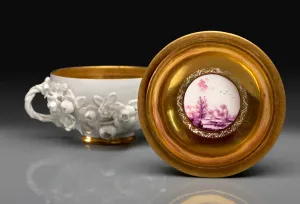Introduction
Although porcelain had been manufactured in China since the seventh century, it did not reach Europe with any regularity until the mid-sixteenth century, after Portuguese ships landed on the south coast of China. During the next two centuries, porcelain was known as “white gold,” prized for its whiteness, durability, and translucency but available in Europe only when imported from Asia. Porcelain’s production remained a mystery in Europe until 1708, when the German chemist Johann Friedrich Böttger (1682–1719) succeeded in producing true (or hard-paste) porcelain by combining local clays containing kaolin (the essential white ingredient) with ground alabaster.
The first formula, or arcanum, was strictly guarded by Böttger’s patron, Augustus the Strong (1670–1733), Elector of Saxony and King of Poland, who, in 1710, founded the Royal Porcelain Manufactory in Dresden, the seat of the Saxon court. Augustus was determined to keep the formula a secret, going so far as to relocate his porcelain manufactory to the secure cliff-top medieval castle Albrechtsburg in Meissen later that year. During the next three years, the Meissen Manufactory produced Böttger’s red stoneware, with shapes derived mostly from Augustus’s silver and East Asian porcelain. After 1713, and throughout the eighteenth century, the manufactory created a large quantity of white porcelain vases, vessels, and figures—some without decoration like the Chinese porcelain from Dehua but most of them beautifully painted with underglazed blue and white or vibrant polychrome colors.
Said to be afflicted with maladie de porcelaine (porcelain fever), Augustus the Strong amassed more than twenty thousand pieces of Chinese and Japanese porcelain, showcasing them alongside Meissen porcelain in a lavish pleasure palace in Dresden on the banks of the Elbe River. A similar porcelain fever beset the late Henry H. Arnhold (1921−2018), a great patron of the arts and a longtime friend of The Frick Collection. The Arnhold collection was begun in Germany in 1926 by Henry Arnhold’s parents, Lisa (1890−1972) and Heinrich (1885−1935). Upon their death, Henry inherited the collection and, over the years, added many pieces to it, sometimes following his parents’ tastes and preferences, other times acquiring pieces such as figures, groups, and mounted objects that were beyond the scope of the original collection. He also acquired many pieces of porcelain once owned by Augustus the Strong.
This exhibition celebrates Henry Arnhold’s bequest to the Frick of more than one hundred pieces of Meissen porcelain, along with several Asian examples, a gift that substantially complements and expands the museum’s rich ceramic holdings. The organization of the exhibition takes its cue from the presentation typical of eighteenth-century European aristocratic collections. Ceramic wares of diverse forms, techniques, and origins, both Asian and European, were often exhibited in extravagant spaces called “porcelain rooms,” where a sense of unity was achieved through arranging them by color. The exhibition echoes this type of display, with objects organized by color: early, so-called red or “Böttger” porcelain; white porcelain; Asian-inspired red, green, and orange porcelain; gilded porcelain; and finally blue-and-white porcelain. This approach allows visitors to experience Meissen porcelain in much the same way as it would have been seen in the grand palaces and aristocratic homes of Europe more than three hundred years ago.
Small Two-Handled Bowl with Cover, 1735 or 1738, model by Johann Joachim Kändler (1706–1775) and/or Johann Friedrich Eberlein (1696–1749), hard-paste porcelain, h. 3 3/4 in. (9.5 cm), Gift of Henry H. Arnhold, 2019; photo: Michael Bodycomb

